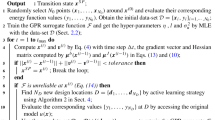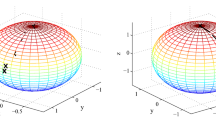Abstract
We propose a model-free shrinking-dimer saddle dynamics for finding any-index saddle points and constructing the solution landscapes, in which the force in the standard saddle dynamics is replaced by a surrogate model trained by the Gassian process learning. By this means, the exact form of the model is no longer necessary such that the saddle dynamics could be implemented based only on some observations of the force. This data-driven approach not only avoids the modeling procedure that could be difficult or inaccurate, but also significantly reduces the number of queries of the force that may be expensive or time-consuming. We accordingly develop a sequential learning saddle dynamics algorithm to perform a sequence of local saddle dynamics, in which the queries of the training samples and the update or retraining of the surrogate force are performed online and around the latent trajectory in order to improve the accuracy of the surrogate model and the value of each sampling. Numerical experiments are performed to demonstrate the effectiveness and efficiency of the proposed algorithm.



Similar content being viewed by others
Data availability
No data was used for the research described in the article.
References
Foresman, J., Head-Gordon, M., Pople, J., Frisch, M.: Toward a systematic molecular orbital theory for excited states. J. Phys. Chem. 96, 135–149 (1992)
Allison, J., Guo, T., Han, Z.: Co-design of an active suspension using simultaneous dynamic optimization. ASME J. Mech. Des. 136, 081003 (2014)
Chen, C., Xie, Z.: Search extension method for multiple solutions of a nonlinear problem. Comput. Math. Appl. 47, 327–343 (2004)
Dauphin, Y., Pascanu, R., Gulcehre, C.: Identifying and attacking the saddle point problem in high-dimensional non-convex optimization. 2012 Proceedings of the 25th International Conference on Neural Information Processing Systems, Cambridge, USA, 2933–2941 (2012)
Denzel, A., Kastner, J.: Gaussian process regression for transition state search. J. Chem. Theory Comput. 14, 5777–5786 (2018)
Deshmukh, A., Allison, J.: Design of dynamic systems using surrogate models of derivative functions. ASME. J. Mech. Des. 139, 101402 (2017)
Doye, J., Wales, D.: The Structure and stability of atomic liquids: From clusters to bulk. Science 271, 484–487 (1996)
Doye, J., Wales, D., Berry, R.: The effect of the range of the potential on the structures of clusters. J. Chem. Phys. 103, 4234–4249 (1995)
Duo, S., Wang, H.: A fractional phase-field model using an infinitesimal generator of \(\alpha\) stable Lévy process. J. Comput. Phys. 384, 253–269 (2019)
Duo, S., Zhang, Y.: Computing the ground and first excited states of the fractional schrödinger equation in an infinite potential well. Commun. Comput. Phys. 18, 321–350 (2015)
E, W., Zhou, X.: The gentlest ascent dynamics. Nonlinearity 24, 1831–1842 (2011)
E, W., Ren, W., Vanden-Eijnden, E.: String method for the study of rare events. Phys. Rev. B 66, 052301 (2002)
D’Elia, M., Du, Q., Glusa, C., Gunzburger, M., Tian, X., Zhou, Z.: Numerical methods for nonlocal and fractional models. Acta Num. 29, 1–124 (2020)
Gao, W., Leng, J., Zhou, X.: An iterative minimization formulation for saddle point search. SIAM J. Numer. Anal. 53, 1786–1805 (2015)
Gould, N., Ortner, C., Packwood, D.: A dimer-type saddle search algorithm with preconditioning and linesearch. Math. Comp. 85, 2939–2966 (2016)
Gu, S., Wang, H., Zhou, X.: Active learning for transition state calculation. J. Sci. Comput. 93, 78 (2022)
Han, Y., Yin, J., Zhang, P., Majumdar, A., Zhang, L.: Solution landscape of a reduced Landau-de Gennes model on a hexagon. Nonlinearity 34, 2048–2069 (2021)
Han, Y., Yin, J., Hu, Y., Majumdar, A., Zhang, L.: Solution landscapes of the simplified Ericksen-Leslie model and its comparison with the reduced Landau-de Gennes model. Proc. Roy. Soc. A-Math. Phy. 477, 20210458 (2021)
Heidrich, D., Quapp, W.: Saddle points of index 2 on potential energy surfaces and their role in theoretical reactivity investigations. Theor. Chim. Acta 70, 89–98 (1986)
Henkelman, G., Jónsson, H.: A dimer method for finding saddle points on high dimensional potential surfaces using only first derivatives. J. Chem. Phys. 111, 7010–7022 (1999)
Koistinen, O., Dagbjartsdóttir, F., Ásgeirsson, V., Vehtari, A., Jónsson, H.: Nudged elastic band calculations accelerated with Gaussian process regression. J. Chem. Phys. 147, 152720 (2017)
Li, Y., Zhou, J.: A minimax method for finding multiple critical points and its applications to semilinear PDEs. SIAM J. Sci. Comput. 23, 840–865 (2001)
Lischke, A., Pang, G., Gulian, M., Song, F., Glusa, C., Zheng, X., Mao, Z., Cai, W., Meerschaert, M., Ainsworth, M., Karniadakis, G.: What is the fractional Laplacian? A comparative review with new results. J. Comput. Phys. 404, 109009 (2020)
Liu, H., Cai, J., Ong, Y.: Remarks on multi-output Gaussian process regression. Knowledge-Based Syst. 144, 102–121 (2018)
Liu, W., Xie, Z., Yi, W.: Normalized Goldstein-type local minimax method for finding multiple unstable solutions of semilinear elliptic PDEs. Commun. Math. Sci. 19, 147–174 (2021)
Liu, X., Zhu, Q., Lu, H.: Modeling multiresponse surfaces for airfoil design with multiple-output-Gaussian-process regression. J. Aircr. 51, 740–747 (2014)
Luo, Y., Zheng, X., Cheng, X., Zhang, L.: Convergence analysis of discrete high-index saddle dynamics. SIAM J. Numer. Anal. 60, 2731–2750 (2022)
Mehta, D.: Finding all the stationary points of a potential-energy landscape via numerical polynomial-homotopy-continuation method. Phys. Rev. E 84, 025702 (2011)
Milnor, J. W.: Morse Theory, Princeton University Press, (1963)
Morse, P.: Diatomic molecules according to the wave mechanics II. Vib. Lev. Phys. Rev. 34, 57–64 (1929)
Nie, Q., Qiao, L., Qiu, Y., Zhang, L., Zhao, W.: Noise control and utility: from regulatory network to spatial patterning. Sci. China Math. 63, 425–440 (2020)
Powel, M.: Algorithms for nonlinear constraints that use Lagrangian function. Math. Programm. 14, 224–248 (1978)
Raissi, M., Perdikaris, P., Karniadakis, G.: Machine learning of linear differential equations using Gaussian processes. J. Comput. Phys. 348, 683–693 (2017)
Rasmussen, C., Williams, C.: Gaussian processes for machine learning. MIT Press, (2006)
Sheng, C., Shen, J., Tang, T., Wang, L., Yuan, H.: Fast Fourier-like mapped Chebyshev spectral-Galerkin methods for PDEs with integral fractional Laplacian in unbounded domains. SIAM J. Numer. Anal. 58, 2435–2464 (2020)
Shi, B., Han, Y., Zhang, L.: Nematic liquid crystals in a rectangular confinement: Solution landscape, and bifurcation. SIAM J. Appl. Math. 82, 1808–1828 (2022)
Song, F., Xu, C., Karniadakis, G.: A fractional phase-field model for two-phase flows with tunable sharpness: algorithms and simulations. Comput. Methods Appl. Mech. Engrg. 305, 376–404 (2016)
Tang, B.: Orthogonal array-based Latin hypercubes. J. Amer. Stat. Assoc. 88, 1392–1397 (1993)
Wales, D.: Energy landscapes of clusters bound by short-ranged potentials. Chem. Phys. Chem. 11, 2491–2494 (2010)
Wang, W., Zhang, L., Zhang, P.: Modelling and computation of liquid crystals. Acta Num. 30, 765–851 (2021)
Xie, Z., Yuan, Y., Zhou, J.: On finding multiple solutions to a singularly perturbed Neumann problem. SIAM J. Sci. Comput. 34, A395–A420 (2012)
Yin, J., Jiang, K., Shi, A.-C., Zhang, P., Zhang, L.: Transition pathways connecting crystals and quasicrystals. Proc. Natl. Acad. Sci. U.S.A. 118, e2106230118 (2021)
Yin, J., Wang, Y., Chen, J., Zhang, P., Zhang, L.: Construction of a pathway map on a complicated energy landscape. Phys. Rev. Lett. 124, 090601 (2020)
Yin, J., Zhang, L., Zhang, P.: High-index optimization-based shrinking dimer method for finding high-index saddle points. SIAM J. Sci. Comput. 41, A3576–A3595 (2019)
Yin, J., Yu, B., Zhang, L.: Searching the solution landscape by generalized high-index saddle dynamics. Sci. China Math. 64, 1801 (2021)
Yu, B., Zheng, X., Zhang, P., Zhang, L.: Computing solution landscape of nonlinear space-fractional problems via fast approximation algorithm. J. Comput. Phys. 468, 111513 (2022)
Zhang, J., Du, Q.: Shrinking dimer dynamics and its applications to saddle point search. SIAM J. Numer. Anal. 50, 1899–1921 (2012)
Zhang, J., Du, Q.: Constrained shrinking dimer dynamics for saddle point search with constraints. J. Comput. Phys. 231, 4745–4758 (2012)
Zhang, L., Chen, L., Du, Q.: Morphology of critical nuclei in solid-state phase transformations. Phys. Rev. Lett. 98, 265703 (2007)
Zhang, L., Chen, L., Du, Q.: Simultaneous prediction of morphologies of a critical nucleus and an equilibrium precipitate in solids. Commun. Comput. Phys. 7, 674–682 (2010)
Zhang, L., Du, Q., Zheng, Z.: Optimization-based shrinking dimer method for finding transition states. SIAM J. Sci. Comput. 38, A528–A544 (2016)
Zhang, L., Ren, W., Samanta, A., Du, Q.: Recent developments in computational modelling of nucleation in phase transformations. NPJ Comput. Mater. 2, 16003 (2016)
Zhang, L., Zhang, P., Zheng, X.: Error estimates of Euler discretization to high-index saddle dynamics. SIAM J. Numer. Anal. 60, 2925–2944 (2022)
Zhang, L., Zhang, P., Zheng, X.: Mathematical and numerical analysis to shrinking-dimer saddle dynamics with local Lipschitz conditions. CSIAM Trans. Appl. Math. 4, 157–176 (2023)
Zhang, L., Zhang, P., Zheng, X.: Discretization and index-robust error analysis for constrained high-index saddle dynamics on high-dimensional sphere. Sci. China Math. (2023). https://doi.org/10.1007/s11425-022-2149-2
Acknowledgements
We greatly appreciate Dr. Siwei Duo for providing the MATLAB code of computing the fractional Laplacian in [10].
Funding
This work was partially supported by the National Key R &D Program of China No. 2021YFF1200500, the Taishan Scholars Program of Shandong Province, and the National Natural Science Foundation of China No. 12225102, 12050002, 12288101.
Author information
Authors and Affiliations
Contributions
LZ: Conceptualization, Funding acquisition, Methodology, Supervision, Writing – review & editing. PZ: Funding acquisition, Supervision. XZ: Formal analysis, Funding acquisition, Investigation, Methodology, Visualization, Writing – original draft.
Corresponding author
Ethics declarations
Conflict of interest
The authors have no conflict of interest.
Additional information
Publisher's Note
Springer Nature remains neutral with regard to jurisdictional claims in published maps and institutional affiliations.
About this article
Cite this article
Zhang, L., Zhang, P. & Zheng, X. A model-free shrinking-dimer saddle dynamics for finding saddle point and solution landscape. Japan J. Indust. Appl. Math. 40, 1677–1693 (2023). https://doi.org/10.1007/s13160-023-00604-8
Received:
Revised:
Accepted:
Published:
Issue Date:
DOI: https://doi.org/10.1007/s13160-023-00604-8




